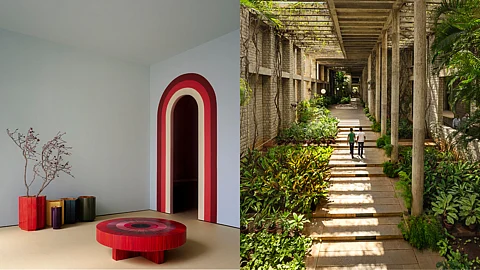
- HOMEGROWN WORLD
- #HGCREATORS
- #HGEXPLORE
- #HGVOICES
- #HGSHOP
- CAREERS
- ABOUT US
- CONTACT US

The way we want to live is changing fast, and a new set of architectural trends is emerging to answer the problems faced by modern life; both spatial and emotional. Architects today are building structures with more space, more flexibility, lower rents, a higher resistance to climate change and sustainability at the forefront of their design. In a dynamic time like this where everyone is trying to improve their lifestyles, we thought we'd bring you up to date on the architectural design trends of 2023 to bring the same shift to your spaces.
Biophilic Architecture
Let's be honest, the reason we seek out these camping trips, hikes and remote resort experiences is because our connection with nature has grown weaker. Boxed inside our technological lives we all feel the need to go out and 'touch grass' which is now manifesting in our spaces where people are merging indoors with outdoors. Through planning and construction of structures that include natural features, and through the use of natural materials, ventilation, vegetation, and natural light management, biophilic structures seek to reveal nature's enlivening effects by incorporating elements of nature into its design.
Smaller Portable Homes
The 'how much rent do you pay in New York' videos have flooded Instagram so much that their satirical versions are out now. But they did give us some great examples of crafting a functional yet aesthetic design out of a small space. Gen Z's priorities lie in their experiences which are also informed in sustainability. Since this generation can't really afford the costs of construction, we have taken comfort in the tiny house movement which uses upcyled materials to create compact houses that in many cases can be relocated with you. These energy-efficient homes inspire contentment and also leave a smaller environmental footprint.
Sensory Design
Since the screens took over, our world has become highly visual. Aesthetics are everything. Our minds are constantly stimulated through those screens and when we look away from them at plain wall, the banality feels almost uncomfortable. Whether its excitement or tranquility, we now look to our surroundings to create an emotional tone which can be achieved with architecture but also interior design. We are beginning to consider the fundamentally multisensory nature of perception that colous, temperature, textures, materials and visual composition can manipulate in a living space, heading towards a future where living experiences are elevated by architecture that engages the entire spectrum of our senses.
If you enjoyed reading this, here's more from Homegrown:
Inside A Kerala Farmhouse Created In Visual & Structural Harmony With Nature
Nuru Karim's Parametric Bookworm Pavillion Is Homegrown Ecological Urbanism In Action
